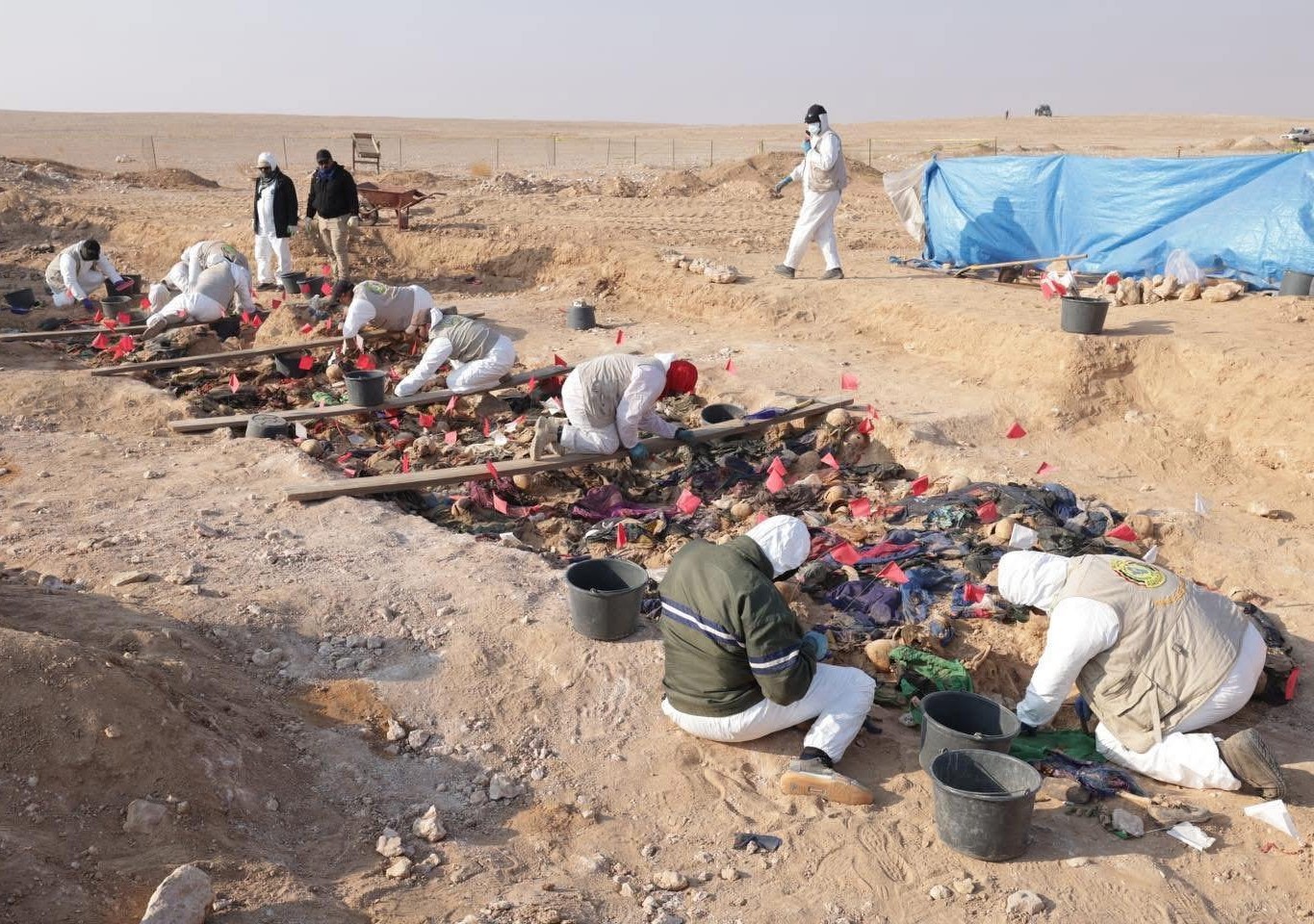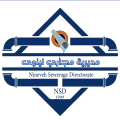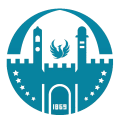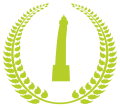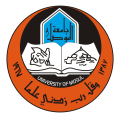The Martyrs Foundation revealed details of the search and excavation operations for mass graves, and while it confirmed that it will hand over the remains of the Tel al-Sheikha cemetery to the forensic medicine department today for the purpose of matching, it indicated its readiness to establish memorials and tombstones for the victims at the grave sites .
Director General of Mass Graves at the Martyrs Foundation, Diaa Karim, said: “In late 2018, the discovery of a mass grave in the Tal al-Sheikha area was announced by the office of the President of the Republic at the time. After that, specialized technical teams from the Martyrs Foundation went to the site and evaluated the site. Indeed, traces of a mass grave were present there .”
He added, “The first grave was opened in July 2019, and it was two meters by 16 meters, all the victims were women and children, with the number of victims reaching 172 victims,” indicating that “during the work, aerial photos of the area were completely analyzed in Tel al-Sheikha, and some variables were diagnosed on the soil surface .”
Test trenches
He explained that “test trenches were conducted, through which we found two other graves, in addition to the existence of other sites that we are still in the process of conducting a technical evaluation of,” noting that “the cadres began opening one of the two confirmed graves 8 days ago, as the completion of the excavation work was officially announced, not the removal of the remains, because the remains have become clear and ready for removal, as there will be removal work starting Monday morning .”
He explained that “all the remains were of women and children wearing Kurdish clothing and date back to the 1980s,” noting that “the area of the grave is almost similar to the previous area, which is 2 meters by 16 meters and a depth of no more than a meter and a quarter, where the women are wearing Kurdish spring clothing, which indicates that the executions took place in the spring .”
He pointed out that “the killing took place in the same hole through the seizure of empty envelopes and the appearance of traces of gunfire on the victims,” stressing that “the operations have been completed by the Martyrs Foundation team and the forensic medicine team with the support of the International Commission on Missing Persons (ICMP), and there is also direct support from the head of the Martyrs Foundation .”
He added, ” Yesterday, Monday, the operations of lifting the remains began, after the completion of the excavation operations,” stressing that the excavator will be directed to other coordinates and the variables will be examined in order to find other graves .”
Mass Graves Law
He pointed out that “Mass Graves Law No. 5 of 2006 was only applicable to the graves of victims of Baath Party crimes, but the circumstances that Iraq went through after 2003 and the sectarian war it witnessed by Al-Qaeda and ISIS prompted us to amend the law to expand its scope to include graves that occurred after 2003,” indicating that “according to the law, the Martyrs Foundation is committed to searching and investigating the sites of mass graves and confirming them, in addition to taking blood samples from the families of the missing in exchange for bone samples to match and determine the identity of the victims. This is what the two laws aim to do by identifying the victims and returning them to their families, whether they are graves of the Baath Party or victims of the terrorist ISIS .”
He stressed that “the number of remains extracted so far is estimated in the thousands, whether from the crimes of the Baath Party, Speicher, Sinjar, Mosul or Badush .”
He explained that “through the analysis of the criminal behavior of the Baath by our team, which consists of archaeologists, legal experts, forensic medicine, forensic photographers and chemists, we find that the former regime was finishing off the victims of Kurdish nationality in the desert triangle between Samawah, Najaf and Diwaniyah, and as for the Shiite victims, it was killing them in the Saqlawiyah area. This was from the beginning of the eighties until the Shaabaniyah uprising,” noting that “after the Shaabaniyah uprising, families were killed in their province, in addition to the fact that the Kurds were killed according to two models, the first being the Barzanis who were killed in the Abu Siya or Al-Afayef area, the area adjacent to the Syrian border, while the Patriotic Union group was killed in the Naqrat Al-Salman and Tal Al-Sheikha areas .”
Challenges of exploration operations
He pointed out that “the challenges facing the discovery operations and the team are many, including at the level of discovering the graves, because it was assumed that all investigations would be completed and the evidence of the perpetrators in the former regime would be revealed, and then these sites would be identified and then our cadres would be involved in the operations of revealing the evidence and cooperating with the judicial authorities, in addition to the aerial photos, as some of them are hidden, especially during the period of ISIS control, when some aerial photos were hidden from the sites, in addition to the high financial cost of obtaining some aerial photos from Airbus or the like, and this is very expensive, and some of them even refrain from providing us with these photos .”
He continued, “This long period of time also affects the issue of reaching some sites, especially those deep in the desert, in addition to the challenges facing the search teams, as some of them suffer from diseases as a result of direct contact with the remains, especially the undecomposed ones that were found after 2003, as well as the environmental difficulty of the graves being in remote areas or in areas that are still witnessing security breaches, and also the danger resulting from snake and scorpion bites, especially since some areas have a lot of this type .”
He continued, saying: “There are also other problems related to financial support for this group that works to open graves, as there are two formations, the first from the Martyrs Foundation and the other from forensic medicine, as the forensic medicine cadres receive 200% of the allocations and the Martyrs Foundation cadres receive 50%, and this constitutes frustration, especially the 50% in comparison to the salary, which is very little .”
Supporting the department with youth cadres
He continued saying: “We as a department are not attractive for work, as we obtained the approval of the Prime Minister to support the department with young cadres because the operations it carries out are very difficult, stressing “the need for there to be interest in the team’s work rate, as we have been working on the current team since 2008 and it was thrown into training in Bosnia and Herzegovina and Australia and has become a well-known figure .”
He continued, “The UNITAD international investigation team, in two briefings to the UN Security Council, praised the team’s work and the scientific methods it follows .”
Memorial to the victims
Regarding the erection of symbolic signs or memorials for the victims, he explained that “there is a special directorate called the Directorate of Commemorating the Victims, in addition to the Department of Relations and Media, which has drawn up an integrated plan for the erection of signs and memorials at the sites of mass graves,” noting that “a while ago, the Bir Alu Antar Cemetery in Mosul was opened and the site was visited and identified in partnership with the local government and the people and dignitaries of the region, and thus they are now agreeing on a design that takes into account all tastes and all spectrums present in this region .”
He pointed out that “the policy adopted by the institution in erecting monuments and headstones in every cemetery that is opened is that it is prepared to conduct a coordinate and thus the monument is erected .”
He explained that “all the remains that were removed will be handed over today to the forensic medicine cadres accompanying our teams, and in turn the remains will be transferred to what is called the dry morgue in forensic medicine, where classification processes will be carried out and bone samples will be taken from each remains to match them with the blood sample to determine the identity of the victims.”

